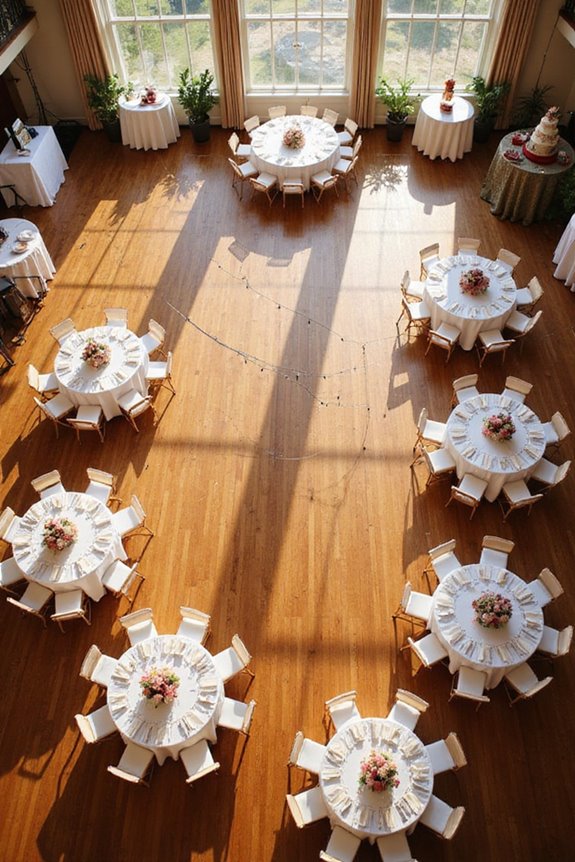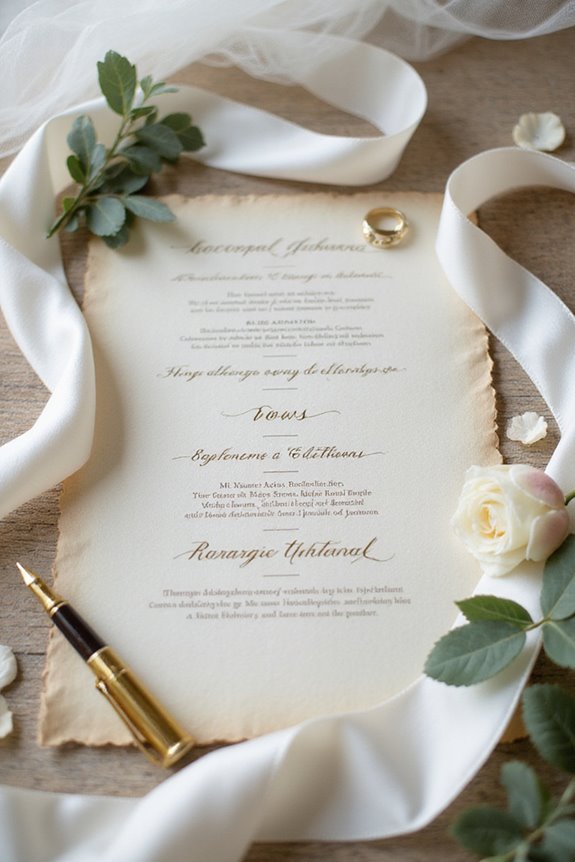Creating a seating chart for your reception can feel a bit overwhelming, but we’ve got your back! Start by understanding the venue layout and space, considering traffic flow. Next, manage your guest list effectively—invite a few extras just in case. For table arrangements, group guests by relationships to spark conversations while keeping rival pals apart. Finally, print clear charts and don’t forget those last-minute blank cards. Stick around, and we’ll cover more planning tips!
Key Takeaways
- Start by measuring venue dimensions and creating a simple floor plan to visualize the layout and seating arrangements.
- Organize your guest list into A-list and B-list, anticipating declines to ensure you have enough attendees.
- Choose table shapes that encourage conversation and group guests by relationships for a lively atmosphere.
- Create a clear seating chart, placing special needs guests closer to exits and ensuring visibility of the head table.
- Print large seating charts and individual place cards, keeping extras for any unexpected guests and coordinating with venue staff for smooth execution.
Understanding Venue Layout and Space Planning
When planning your reception, understanding the venue layout and space is essential—after all, a well-organized space can make or break the vibe of your event. First, let’s measure the venue dimensions to grasp any spatial constraints. Knowing how much room we have helps us arrange tables and chairs comfortably. Consider any fixed structures, like pillars or stages, that might block pathways.
Next, think about traffic flow. We want guests to move freely without bumping into each other. Position essentials like the bar and restrooms strategically, ensuring easy access. Finally, let’s visualize the layout. A simple floor plan can help us see how everything fits together, making adjustments easy. Remember, a little planning goes a long way!
Managing Your Guest List Effectively

Creating a seating chart starts with knowing who’s coming to the party. Effective guest list management is essential. We should start by creating an A-list of our must-have guests and a B-list to fill in the gaps if some decline. Remember, about 17% to 20% of invitees might say no, so let’s plan ahead.
To keep track, using digital RSVP tracking tools can simplify our lives. These tools help us monitor responses in real-time and adjust our seating and catering needs accordingly. We can also follow up with those who haven’t responded yet. Plus, inviting a few extra guests—about 5-10% more—can help us avoid last-minute surprises. Let’s keep it fun and organized!
Strategies for Table Arrangement and Seating Logic
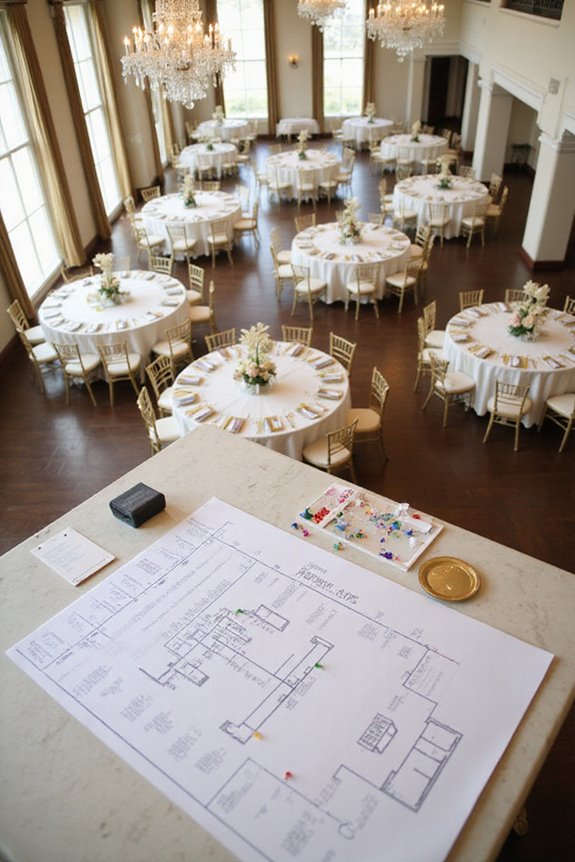
Table arrangement and seating logic can feel a bit overwhelming, but we’re here to simplify it. First, let’s consider the table shape. Round tables promote conversation, while rectangular ones are great for larger groups. Next, think about guest dynamics. Grouping guests by relationships—like family or friends—can spark lively conversations. Just avoid seating known rivals together; we don’t want any drama!
Now, let’s not forget about accessibility. Place guests with special needs closer to exits and amenities. Finally, using a clear seating chart displayed at the entrance helps everyone find their spot easily. Remember, the goal is to create a comfortable atmosphere where everyone feels included and can enjoy the celebration together!
Prioritizing Head Table and VIP Seating
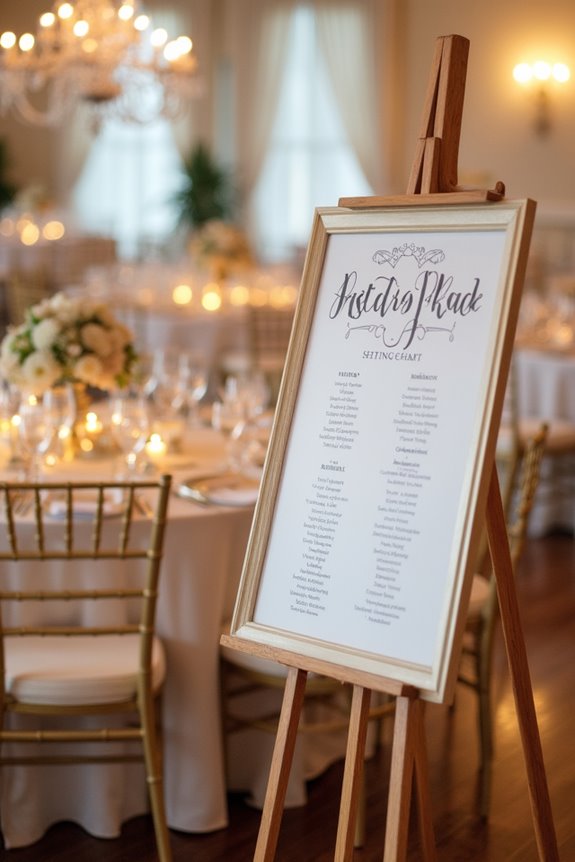
Prioritizing the head table and VIP seating can really set the tone for your reception. First, let’s think about head table etiquette. We usually center the couple and place the bridal party on either side. Including partners makes it more lively! Next, VIP guest placement is key. We should seat close family, like parents and grandparents, near the head table to honor them and keep communication easy. This also respects family dynamics, which can be a delicate dance. Remember, our layout should allow for good visibility of speeches and celebrations. And if we can avoid any awkward seating arrangements, that’s a win! Clear signage helps guests find their way, so let’s keep it simple and inviting.
Finalizing and Executing Your Seating Chart On-Site
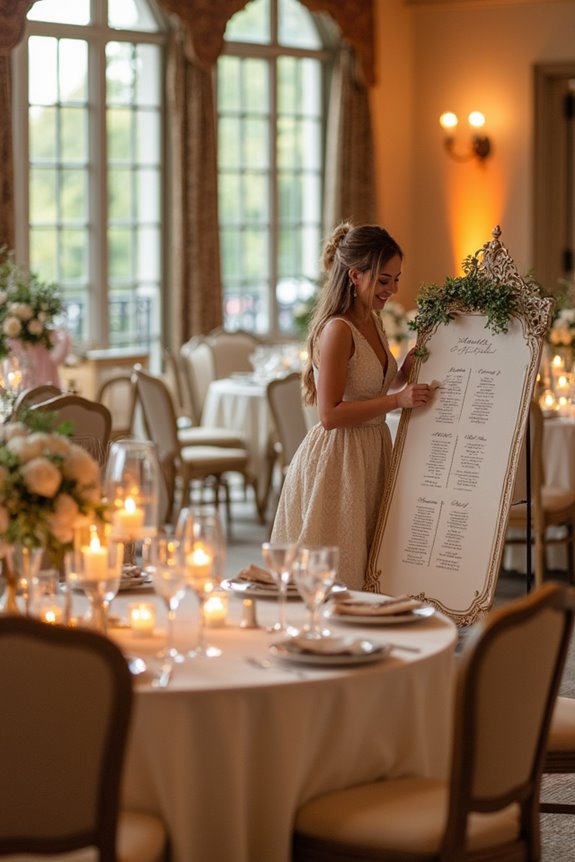
When it comes to finalizing and executing your seating chart on-site, it’s all about staying organized and flexible. First, let’s tackle our final preparations. We’ll print large seating charts and individual place cards, ensuring they’re easy to read. For those unexpected guests, keeping extra blank cards handy is a lifesaver!
Next, on-site adjustments can make or break our flow. If last-minute changes arise, use a digital seating chart for quick modifications. Communicate with the venue staff about any special needs or seating conflicts. As guests arrive, let’s keep our cool and guide them smoothly to their seats. Remember, it’s all part of the adventure! We’re here to create a memorable experience for everyone, so let’s keep it fun and stress-free!
Frequently Asked Questions
How Do I Handle Last-Minute Guest Additions or Cancellations?
When handling last-minute guest additions or cancellations, we prioritize flexible arrangements for effective guest management. Keeping open seats and clear communication allows us to adapt quickly, ensuring everyone feels welcomed without disrupting the overall flow.
Should I Consider Cultural Seating Customs for My Guests?
Absolutely, we should consider cultural norms and guest preferences when planning seating. By respecting traditions, we enhance everyone’s experience, fostering connections while ensuring our celebration honors diverse backgrounds and creates a welcoming atmosphere for all.
What if Guests Have Conflicting Relationships or Tensions?
When we face conflicting relationships among guests, we’ve got to prioritize conflict resolution and practice guest diplomacy. Thoughtful seating arrangements can ease tensions, ensuring everyone enjoys the event without discomfort or awkwardness.
How Can I Make Seating Arrangements More Interactive?
Imagine a digital age where seating charts become an adventure! By incorporating interactive seating options, we can boost guest engagement, allowing everyone to connect and explore their placements through fun activities and tech innovations.
What Tools Can Help Visualize the Seating Chart Better?
To visualize our seating chart better, we can use seating software with visual templates. These tools allow us to create engaging layouts and easily adjust arrangements, making the planning process more enjoyable and efficient.


